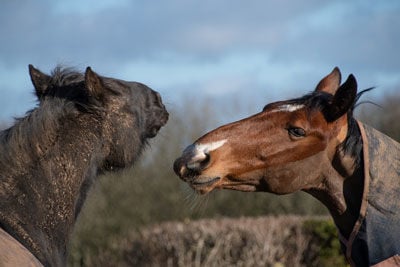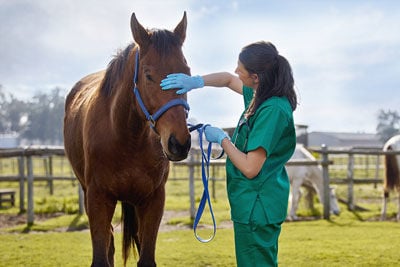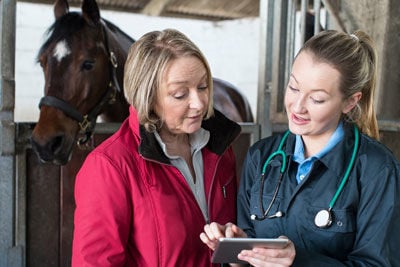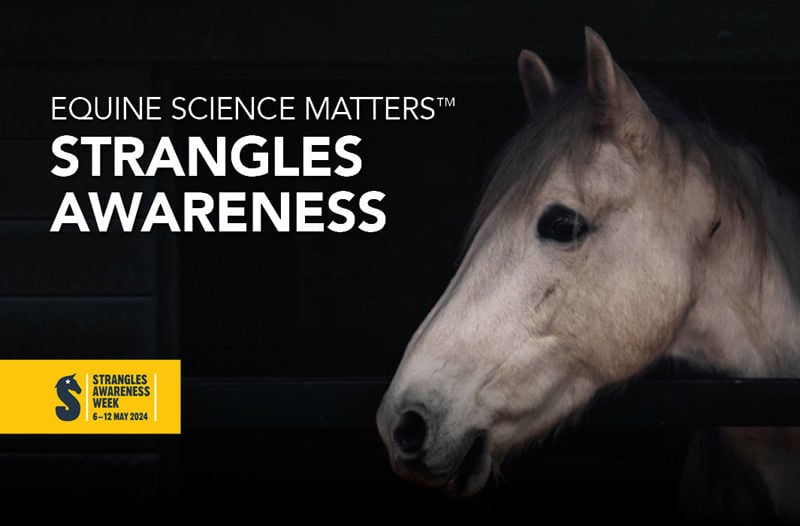What is Strangles?
Strangles is the most commonly diagnosed equine infectious disease worldwide. It is an extremely contagious illness that affects the upper respiratory tract and is caused by a bacteria called Streptococcus equi. The bacteria infect the lymph nodes around the jaw, causing them to become swollen. Strangles affects any horse, regardless of age, health or breed.
What are the symptoms of Strangles?
- Fever
- Thick nasal discharge
- Depression
- Cough
- Painful abscesses
- Laboured breathing
- Difficulty eating
The earliest sign of Strangles is a high fever, with a resting temperature above 38.5oc and it can take up to 21 days for a newly affected horses to show signs of illness. Even horses showing mild symptoms can pass on the illness to other horses who may be affected more severely. Horses can take up to 6 weeks to recover from Strangles and up to 10% of previously infected horses will remain carriers and therefore could pass on the disease without showing any symptoms themselves.
How is Strangles spread?
Strangles is not airborne however horses that cough or sneeze can spread infected material several feet. Bacteria spread rapidly via direct horse-to-horse contact but can also be spread indirectly through contact with surfaces, clothing, and equipment.

Strangles bacteria can be spread by direct contact
Some horses become 'Strangles carriers' after being infected, which makes the disease even more challenging. This means they still have Strangles bacteria hidden in their respiratory system, but aren’t showing any outward symptoms. Carriers can shed bacteria intermittently, able to infect other horses without anyone knowing where the disease has come from.
It is vital all horses are checked as they recover from strangles so treatment can be used to help them clear any remaining infection and prevent them becoming carriers.
How is strangles diagnosed?
There a number of different ways that vets can test for Strangles, depending on the circumstances. They will usually start with a visual examination to look for external signs of the disease and check the horse’s temperature.

Vets usually start with a visual examination to look for external signs of Strangles
They can then take samples to be sent for testing to help confirm or rule out Strangles infection:
Swabs – take samples of discharge from a horse’s nostrils or a burst abscess and are often used in the early stages of infection. Specialist swabs can take samples from the top of a horse’s nasal passages where bacteria are likely to be present in an infected horse. Swabbing is less reliable than endoscopy, and repeat tests are often needed to increase confidence in a negative result.
Guttural pouch endoscopy – an endoscope is used to enter both the horse’s guttural pouch, which are air sacs at the top of each nasal passage. Strangles loves guttural pouches as this is where bacteria can survive longer than the illness it causes. Checking and taking samples from the guttural pouches should be routine for any horse that is known or suspected to have had strangles so infection can be found and cleared before it spreads.
Blood samples – can contain Strangles antibodies that the horse’s immune system produces as a response to infection or in a horse that has become a Strangles carrier. It can take up to two weeks for antibodies to be detected in a blood sample, so this test is less likely to be used for horses in the early stages of disease. Not every horse with Strangles antibodies will be infected so further testing is usually needed to determine if the blood result is caused by live bacteria or not.
How is Strangles prevented?
Outbreaks are often expensive, exhausting and emotional to deal with, and strangles is a potentially fatal disease for infected horses, so prevention is always better than cure.
Strangles can be prevented through good yard management and high biosecurity including:
- Isolating, monitoring and testing new horses that come on to the yard for two to three weeks to ensure they don’t develop any symptoms of Strangles.
- Avoid sharing equipment and facilities with others if you don’t know their horse’s Strangles status
- Travel safely by cleaning and disinfecting vehicles between trips
- When out and about with your horse at shows, avoid direct contact with other horses, don’t allow them to drink from shared water outlets and ensure the stable your horse is kept in is disinfected before use.
- Vaccines are available and can help reduce the chance of a horse becoming infected or reduce the severity of their symptoms. Speak to your vet to find out more.
How is Strangles treated?
Although Strangles cannot be cured once a horse has been infected, it is still important the horse received the correct veterinary care as early as possible so that the severity of the symptoms can be targeted with medication and any issues such as laboured breathing or difficulty in eating or drinking can be treated.
Keeping the horse comfortable during through their illness is important to help them recover. Feeding soaked feed and forages can also make it easier for them to eat while also increasing their water intake.
If your horse has an abscess, keeping it clean is important. Regular, warm poultices can help them to burst which will relieve the pressure.
What should I do if I think a horse may have Strangles?
The most important thing to do if you are worried your horse has Strangles is to contact your vet immediately. The sooner they start treating your horse, the better your horse’s chance of making a full recovery.

Your vet will be able to advise about ongoing care
There is stigma associated with having an animal suffering with the condition, however is not a reflection on the care that animal receives. There is no shame in owning a horse with the disease, or having the disease on the premises, and people should support each other and work together to reduce the risk of contamination and passing the disease on.
Isolation of horses is incredibly important as it greatly reduces the chances of passing the disease onto others. As responsible horse and yard owners, it is encouraged to notify others, including neighbouring yards, if you suspect a case and “lock down” the yard - meaning no equines are to leave, or new ones are to come on to the premises. Your vet will be able to diagnose if Strangles is present and offer treatment and advice. All horses should be monitored with regular temperature checks and notify your vet of any new cases.
Click here for more information about Strangles Awareness Week 2024.
For any advice or questions you may have, please don't hestiate to reach out to our expert nutrition team. You can call 0800 585525 Monday-Friday 8:30am-5:00pm. Email [email protected], or send us a DM on social media.


